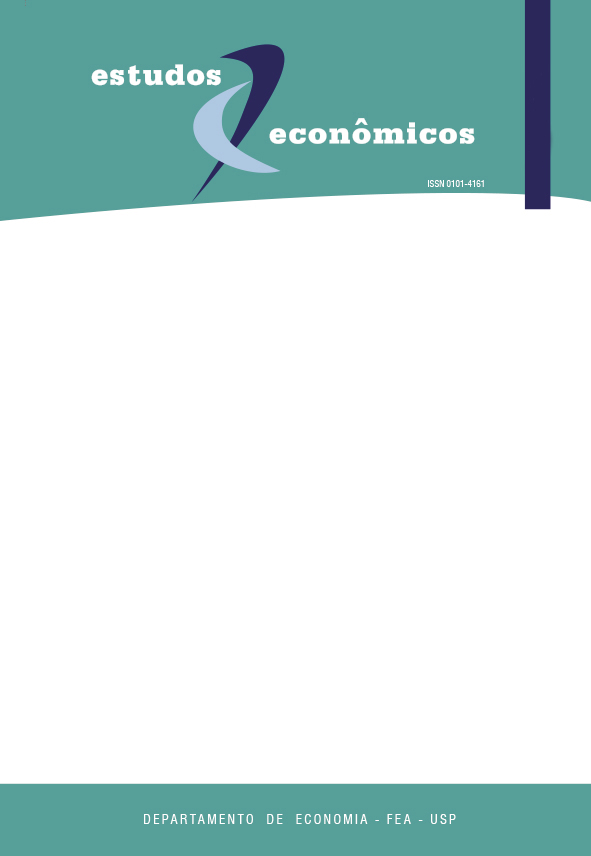A dinâmica da taxa de lucro, da taxa de juros e do grau de utilização da capacidade produtiva em um modelo pós-keynesiano
DOI:
https://doi.org/10.1590/S0101-41612007000400008Keywords:
macroeconomic dynamic models, post-keynesian theory, computational simulationAbstract
The objective of this paper is to analyze the dynamic path of the profit rate, the interest rate, the rate of capital accumulation and the degree of utilization of the productive capacity - face exogenous changes of the intensity of technological progress and the propensity to save of capitalists within a Post-Keynesian macroeconomic dynamic model that join the real and monetary side of the economy. The computational simulation allowed investigating the degree of proximity of the model to the dynamics of a real economy. The simulation showed, amongst other results, that: (i) the profit rate is significantly elastic with regard to the rate of technological progress, while the interests rate and the degree of utilization of the capacity are little sensible to this variable; and (ii) the confirmation of the paradox of the thrift, according to which an increase of the propensity to save of the capitalists reduces the level of the aggregate saving.Downloads
References
Blanchard, O. Macroeconomia: teoria e política. 1ª ed. Rio de Janeiro: Campus, 1999.
Carvalho, F. C. Moeda, produção e acumulação: uma perspectiva pós-keynesiana. In:
Moedas e produção: teorias comparadas. Brasília, Unb, 1992.
Davidson, P. Money and the real word. 2ª ed. Londres: MacMillan, 1978.
Dutt, A. K. Stagnation, income distribution and monopoly power. Cambridge Journal of Economics, 8, 1984.
Dutt, A. K. Accumulation, distribution and inflation in a marxian/post keynesian
model with a rentier class. Review of Radical Political Economics, 21(3), p. 18-26, 1989.
Dutt, A. K. Growth, distribuction and uneven development. Cambridge: Cambridge
University Press, 1990.
Dutt, A. K. Expectations and equilibrium: implications for Keynes, the neo-ricardian
keynesians, and the post-keynesians. Journal of Post Keynesian Economics, vol.14, n° 2, 1992.
Dutt, A. K. On the long-run stability of capitalist economies: implications of a model of growth and distribution. In: Dutt, A. K. (org.), New directions in analytical political economy. Aldershot: Edward Elgar, 1994.
Dutt, A. K; Amadeo, E. J. A post-keynesian theory of growth, interest and money.
In: Baranzini; Harcourt, G. C. (Eds.). The dynamics of the wealth of nations: growth,
distribution and structural change. New York: M. St. Martins’s Press,1993.
Fiocca, D. A oferta de moeda na macroeconomia keynesiana. São Paulo: Editora Paz e
Terra, 2000.
Hansen, L.; Heckman, J. The empirical foundations of calibration. Journal of Economic
Perspectives, v. 10, n.1, 1996.
Harrod, R. An essay in dynamic theory. Economic Journal, v.49, mar. 1939.
Hicks, J. Mr. Keynes and the classics: a suggested interpretation. Econometrica, 1937.
Jarsulic, M. Endogenous credit and endogenous business cycle. Journal of Post Keynesian,
v. 12, n. 1, p. 35-47, 1989.
Kaldor, N. Marginal productivity and the macroeconomic theories of distribution.
In: Panico, Carlo; Salvadori, Neri, Post keynesian theory of growth and distribution. Cambridge: University Press, 1993.
Kalecki, M. Selected essays on the dynamics of the capitalist economy. Cambridge University
Press, 1971.
Keynes, J.M. The ex-ante theory of the rate of interest. In: Moggridge, D. (Org.).
The collected writings of John Maynard Keynes. Cambridge: Cambridge University Press, Vol. XIV, 1973.
Kydland, F. E.; Prescott, E. C. The computational experiment: an econometric tool. The Journal of Economic Perspectives, v. 10, n.1, winter, 1996.
Kregel, J. A. Hamlet without the prince: Cambridge macroeconomics without money. American Economic Review, 1985.
Lima, G. T. Progresso tecnológico endógeno, crescimento econômico e distribuição de
renda. In: Lima, G. T; Sicsú, J.; De Paula, L. F. (orgs), Macroeconomia moderna:
Keynes e a economia contemporânea. Rio de Janeiro: Campus, 1999.
Lima, G. T; Meirelles, A. J. Mark-up bancário, conflito distributivo e utilização da
capacidade produtiva: uma macrodinâmica pós-keynesiana. Revista Brasileira de Economia, Jan. - mar, 2003.
Nelson, R.; Winter, S. An evolutionary theory of economic change. Cambridge: Harvard
University Press, 1982.
Pollin, R. Two theories of money supply endogeneity: some empirical evidence. Journal of Post Keynesian Economics, v. 13, n. 2, Spring, 1991.
Rowthorn, R. Demand, real wages and economic growth. Thames Papers in Political Economy. Fall, 1981.
Runde, J. Keynesian uncertainty and liquidity preference. Cambridge Journal of Economics,
, 1994.
Runde, J. Risk uncertainty and bayesian decision theory: a keynesian view. In: Dow, S;
Hillard, J. (org.), Keynes, knowledge and uncertainty. Edward Elgar: Aldershot, 1995.
Samuelson, P. Fundamentos da análise econômica. São Paulo: Abril Cultural, (1983)
[edição original: 1945]
Schumpeter, J. The theory of economic development. 2ª ed. Nova York: Harper & Brothers,
[1912].
Schumpeter, J. History of economic analysis. Nova York: Oxford University Press, 1954.
Simon, H. A. A racionalidade do processo decisório em empresas. Edições Multiplic, v. 1, n. 1, p. 25-60, 1980.
Vercelli, A. Methodological foundations of macroeconomics: Keynes and Lucas. Cambridge:
Cambridge University Press, 1991.
Watanabe, K-I. An endogenous growth model with endogenous money supply: integration
of post-keynesian growth models. Banca Nazionale Del Lavoro Quarterly Review, 200, mar., 1997.
You, Jong-Il. Macroeconomic structure, endogenous technical change and growth. Cambridge Journal of Economics, 18, 1994.
Downloads
Published
Issue
Section
License
Copyright (c) 2007 Luciano Dias de Carvalho, José Luís Oreiro

This work is licensed under a Creative Commons Attribution-NonCommercial 4.0 International License.
By submitting an article, the author authorizes its publication and attests that it has not been submitted to any other journal. The original article is considered final. Articles selected for publication are proofread for grammatical and orthographic errors. The journal does not pay rights for published articles. The Institute of Economic Research from the School of Economics, Business and Accounting of the University of São Paulo (Instituto de Pesquisas Econômicas da Faculdade de Economia, Administração e Contabilidade da Universidade de São Paulo) owns the journal's copyright.




